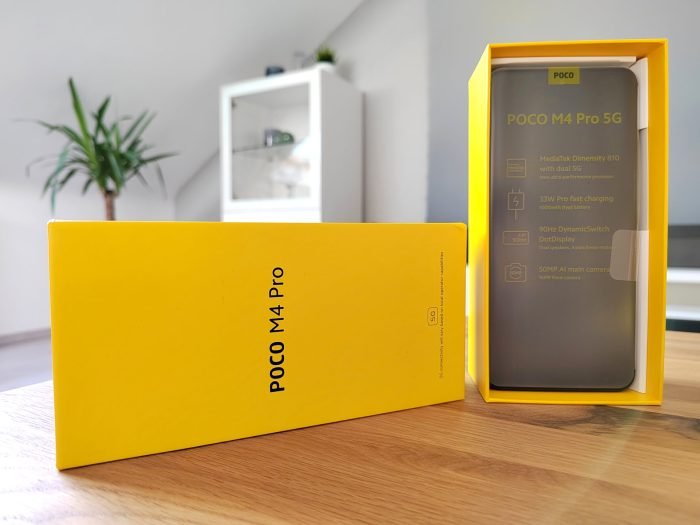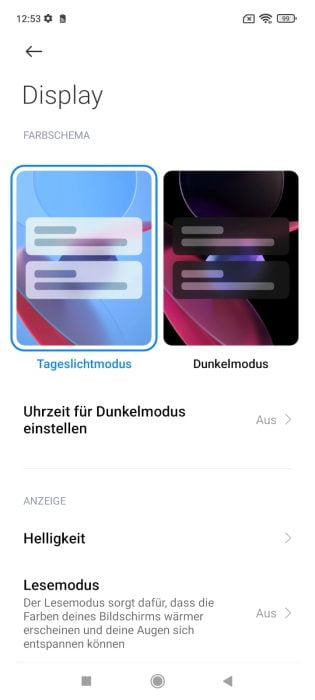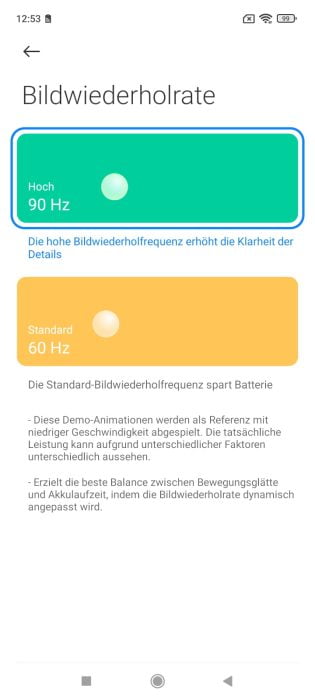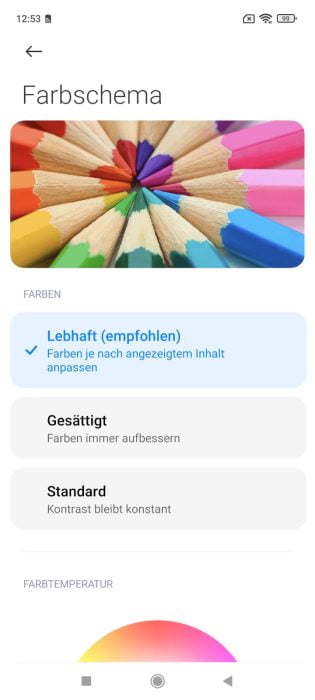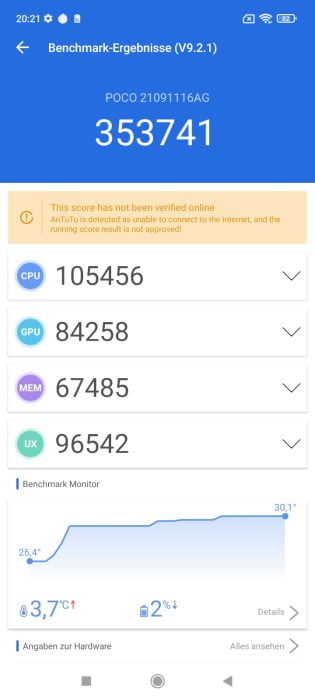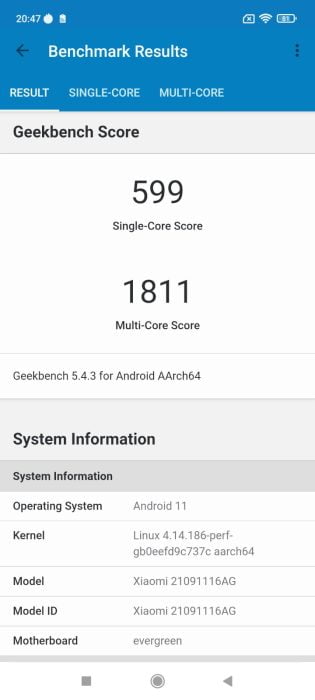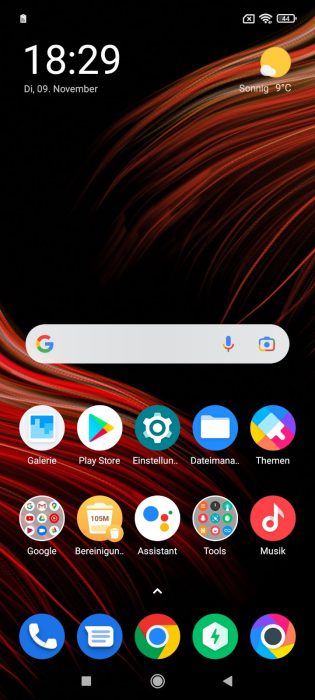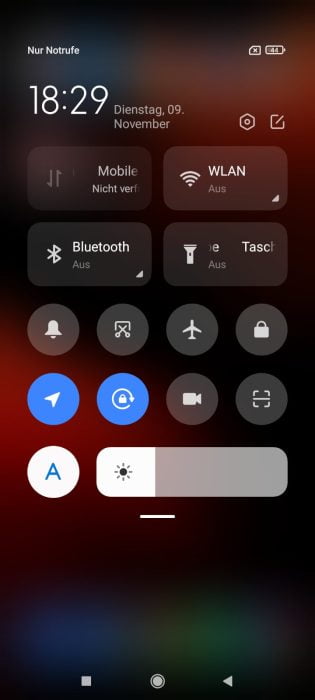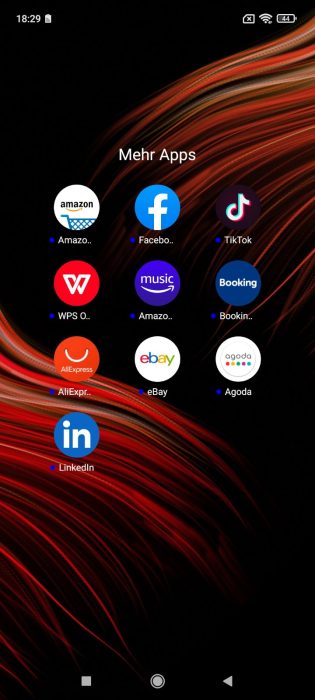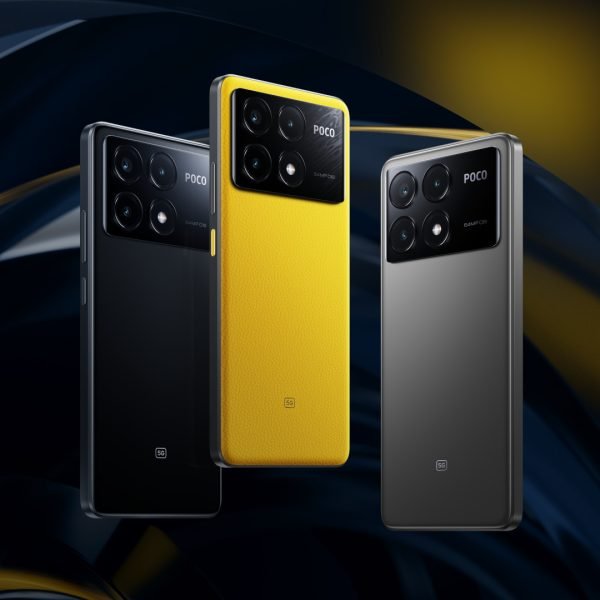Review: POCO M4 Pro 5G
After the success of Little M3 Pro 5G POCO sends the successor into the race just six months later. In direct comparison, the POCO M4 Pro 5G offers a slightly larger display, an improved main camera, more performance and faster charging.
Most of the improvements, however, are in the details and the POCO M4 Pro doesn't make huge leaps compared to its predecessor. We have compared all the differences here in the table.
| Model | LITTLE M4 Pro | LITTLE M4 Pro 5G | LITTLE M3 Pro 5G |
| chip | MediaTek Helio G96 - 7nm | MediaTek Dimensity 810 - 6nm | MediaTek Dimensity 700 - 7nm |
| CPU | Octa-core (2x2.05 GHz Cortex-A76 & 6x2.0 GHz Cortex-A55) | Octa-core (2x2.4 GHz Cortex-A76 & 6x2.0 GHz Cortex-A55) | Octa-core (2x2.2 GHz Cortex-A76 & 6x2.0 GHz Cortex-A55) |
| GPU | Mali-G57 MC2 | Mali-G57 MC2 | Mali-G57 MC2 |
| Storage | 6+128GB, 8+256GB UFS2.2 | 4+64GB, 6+128GB UFS2.2 | 4+64GB, 6+128GB UFS2.2 |
| Display | 6,43 inch AMOLED - 90 Hz - 1080 x 2400 pixels - DCI-P3 | 6,6 inch LC display - 90 Hz - 1080 x 2400 pixels - DCI-P3 | 6,5 inch LC display - 90 Hz - 1080 x 2400 pixels - sRGB |
| sampling rate | 180 Hz | 240 Hz | 180 Hz |
| Cameras | 64 MP, f / 1.8, 26mm, PDAF 8 MP, f / 2.2, 118˚ wide angle 16 MP, f / 2.4, front |
50 MP, f / 1.8, 26mm, PDAF 8 MP, f / 2.2, 119˚ wide angle 16 MP, f / 2.5, front |
48 MP, f/1.8, 26mm, 1/2.0", 0.8µm, PDAF 2 MP, f / 2.4, macro 2 MP, f / 2.4, depths 8 MP, f / 2.0, front |
| Loudspeakers | stereo | stereo | Mono |
| NFC | Ja | Ja | Ja |
| Battery | 5000 mAh - 33W fast charging | 5000 mAh - 33W fast charging | 5000 mAh - 18W fast charging |
| Height Weight | 159.9 x 73.9 x 8.1mm - 179.5g | 163.6 x 75.8 x 8.8mm - 195g | 161.8 x 75.3 x 8.9mm - 190g |
In the meantime, POCO has also released a POCO M4 Pro without fast 5G mobile communications. The smartphone is equipped with a slightly weaker system-on-chip, but it also offers a larger memory, an AMOLED display instead of an LC display and a 64 MP main camera. There are also some differences in design. In contrast to the POCO M4 Pro 4G, the POCO M5 Pro is the slightly more compact device. The following test refers to the POCO M4 Pro 5G.
POCO M4 Pro: design and workmanship
POCO's corporate color is yellow and this is already shown by the bright yellow box, which not only contains the smartphone but also a transparent protective cover, a 33W fast charger, a USB-C cable, a SIM needle, stickers and a quick guide.
The design of the POCO M4 Pro is unmistakable. The back is particularly eye-catching because the camera is surrounded by a huge black box that contrasts strongly with the rest of the housing. The smartphone is available in "Cool Blue", "POCO Yellow" and "Power Black". There should be something for everyone. Our test device has the color "Power Black", which is less reminiscent of black and more of a dark gray.
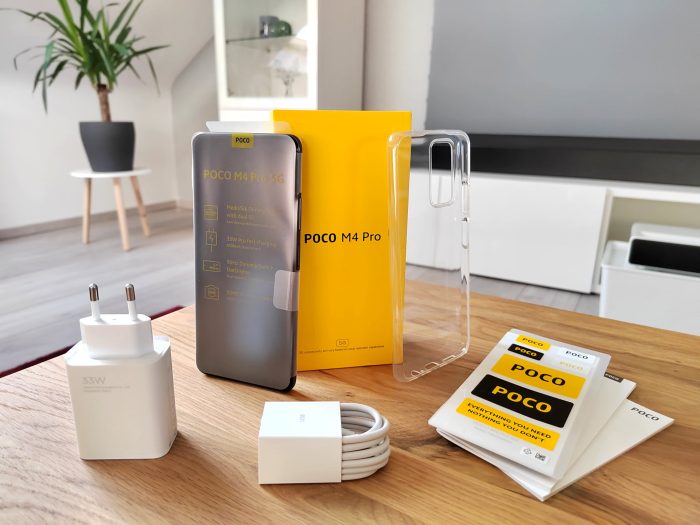
But back to the black box, which adorns a large POCO print next to the camera. The camera is on the left and only protrudes a few millimeters. At first glance you think of 5 cameras. In fact, the POCO M4 Pro only has 2 cameras installed. The other "cameras" are purely decorative and only printed on them. If you ignore the black frame, the POCO M4 Pro resembles the Redmi Note 11, which was recently presented in China. Even the hardware of both smartphones is identical.
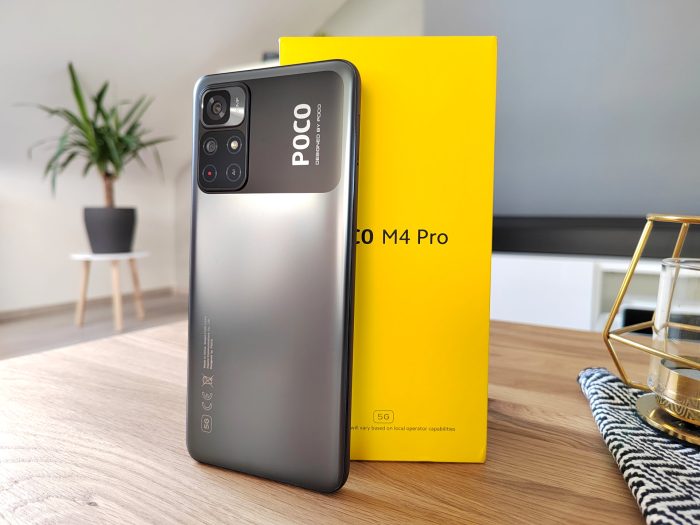
The plastic back finally merges into the frame, which is also made of plastic. Although a lot of plastic has been used, the smartphone doesn't feel cheap. However, the susceptibility to fingerprints can be criticized. Once in hand, the back of our gray test device is already dirty.

According to IP53, the smartphone is not completely waterproof, but is very well protected against splash water such as rain. You will notice this when you remove the SIM slot, which is provided with a red sealing ring. Either two nano-SIM cards or one nano-SIM card and a microSD memory card can be inserted into the SIM slot.
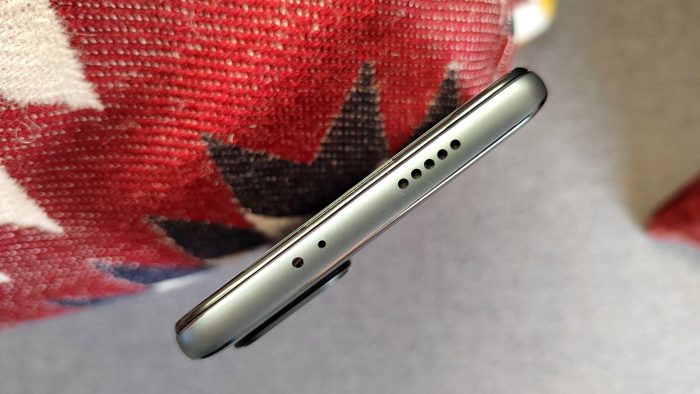
If we walk around the frame, there is the USB-C socket, a microphone, a 3.5 mm jack and one of the two speakers at the bottom. The SIM card slot is on the left, the power button with integrated fingerprint scanner and volume rocker above it is on the right. The buttons are easily accessible with one hand and the smartphone lies securely in the hand. At the top we would have the second loudspeaker, another microphone and an IR transmitter that can be used to control televisions and other devices with IR receivers.
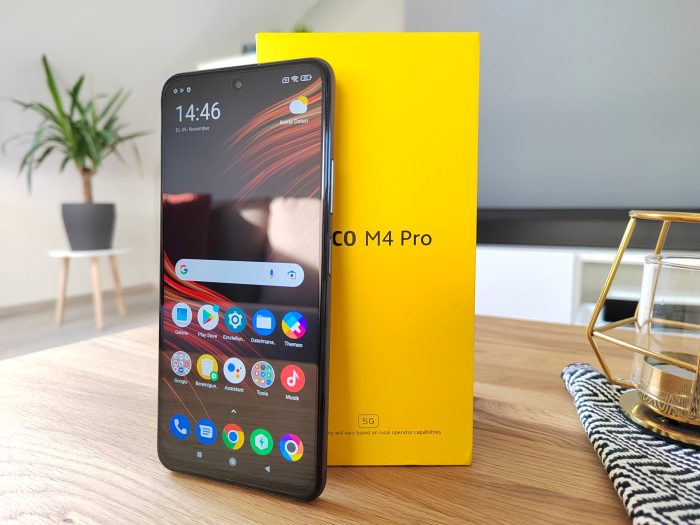
At the front we finally have the 6,6 inch LC display, which is protected by scratch and break-resistant Corning Gorilla Glass 3. The black display bezels are not particularly small, but that's not unusual in this price range. POCO has hidden the 16MP front camera in the center of a punch hole.
POCO M4 Pro: display
We also stick to the 6,6 inch LC display, which has a resolution of 1080 x 2400 pixels and reaches 399 PPI. In a direct comparison with the POCO M3 Pro, which has 405 PPI due to the smaller screen diagonal and the same resolution, the sharpness of the display does not change in spite of the lower PPI of the POCO M4 Pro. The display is particularly fluid thanks to the 90 Hz refresh rate. If you are wondering why the display feels jerky after starting it for the first time, you should switch to the display settings as soon as possible.
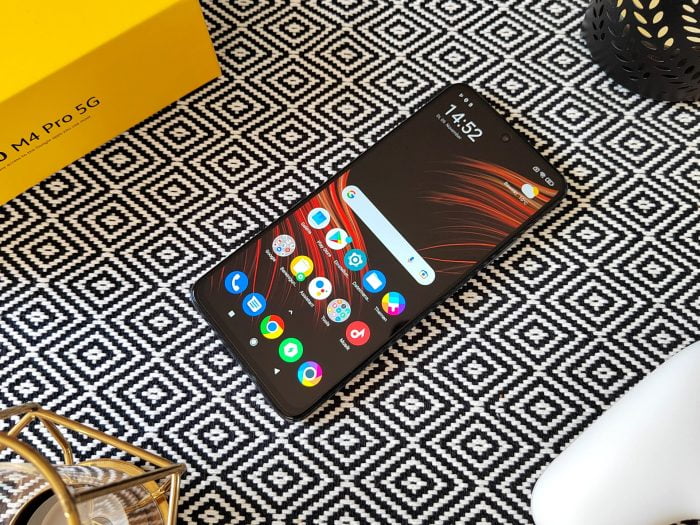
Our test device was set to 60 Hz by default. If you select 90 Hz, the difference is immediately noticeable. At the same time, the higher refresh rate also reduces the battery life. To counteract this, the smartphone dynamically adjusts the refresh rate (50, 60 and 90 Hz) to the content. The sampling rate is 240 Hz, which means that the touchscreen works quickly and precisely.
Although the POCO M4 Pro does not have an AMOLED display, the colors are pleasantly crisp and the contrast is good. The POCO M3 Pro now covers the extended DCI-P4 color space. The color space plays a decisive role, especially in US film production. Widevine L1 is also supported, so that Netflix, Disney + and other streaming services can be streamed in high resolution. Individual settings for the display can be made via the display settings. This is where the POCO M4 Pro does not differ from other mid-range smartphones. In addition to the (adaptive) brightness adjustment, you have the choice between a daylight and a dark mode and you can adjust the colors in 3 predefined color profiles.
The brightness of the display is just enough to be able to read the display reasonably in the sunshine. If the sun hits the display directly, even the sunlight mode does not help, which increases the display brightness again. The highly reflective display glass is also to blame. Other smartphones in this price range are neither better nor worse on this point.
POCO M4 Pro: performance and user interface
The POCO M4 Pro is powered by a MediaTek Dimensity 810 chip, which includes an 8-core CPU (2 x 2.4 GHz Cortex-A76 & 6 x 2.0 GHz Cortex-A55), a Mali-G57 MC2 GPU and a 5G modem. Compared to the Dimensity 700 of the POCO M3 Pro, the chip has a slightly higher CPU performance and is manufactured using the more efficient 6nm process. You can see the details in the table above. However, this difference is hardly noticeable in the benchmarks. Especially not in everyday life.
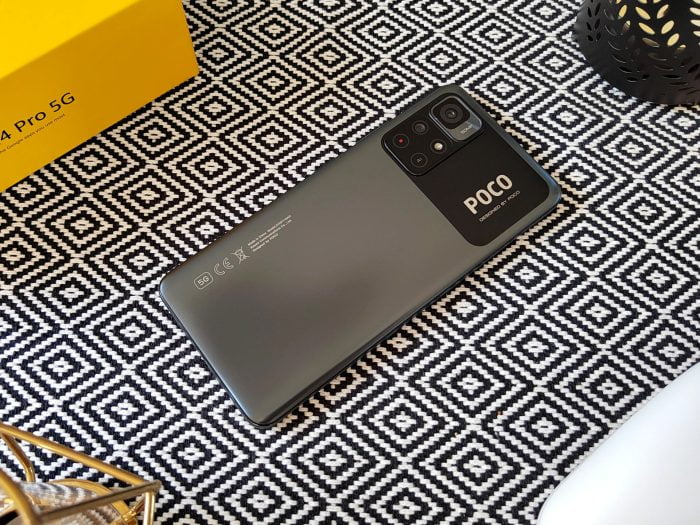
When it comes to storage, you can choose between 4 + 64GB or 6 + 128GB. The main memory is of the type LPDDR4X, the data memory of the type UFS2.2. Both memories showed high write and read rates in the test. The POCO M4 Pro cuts a good figure in everyday life. The MIUI 11 user interface, which is based on Android 12.5, reacts quickly and is easy to use, apps open without long loading times and apps that are already open are also kept in the memory for a long time.
In mobile games it becomes noticeable that the POCO M4 Pro is not a high-end device. If you like to play demanding games, you have to turn down the graphic details. Most games can be played smoothly on a low level of detail. POCO has the heat development under control. Thermal throttling, that is, the performance is reduced, does not occur.
MIUI 12.5 is not only used in devices from Xiaomi, but also in POCO. The user interface is clearly structured and particularly rich in functions. With the help of extensive themes, the design (icons, backgrounds, effects) can be individually adapted. Unfortunately, POCO has not done without annoying third-party apps and games. However, the unwanted apps can be uninstalled via the app settings.
There are also a number of useful tools, such as a QR code scanner, an FM radio, a screen recording function, a split-screen mode and advanced data protection settings. If you link the smartphone with a Mi account, you have access to other Xiaomi services, such as the Xiaomi Cloud. An update to Android 12 will most likely be released in the course of the next year.
POCO M4 Pro: camera
POCO has put the red pencil on the camera and deleted the macro and depth sensor of the POCO M3 Pro and built an 4MP ultra-wide-angle camera in the POCO M8 Pro in addition to the new main camera.
However, you shouldn't mourn the painted sensors, because less is more here. The two 2MP sensors of the POCO M3 Pro are much more wasted than they are of any greater use. An 8MP ultra-wide-angle camera is much more advantageous here (provided the recording quality is right).
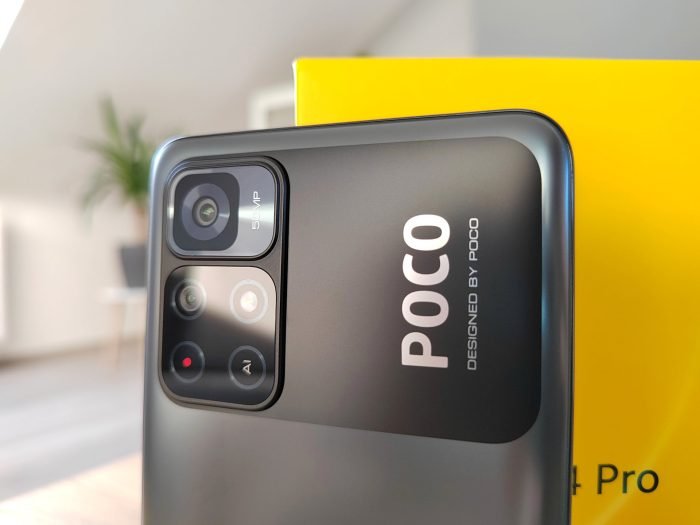
The main camera of the POCO M4 Pro uses the same 50MP Samsung ISOCELL S5KJN1 image sensor that is already in the Redmi 10 (our test) was installed. The sensor uses Samsung's Tetracell technology (pixel binning), which combines four individual pixels into one large pixel.
The resolution of the images is reduced by a quarter as a result, but the technology improves the signal-to-noise ratio and ensures higher light sensitivity, which results in (theoretically) better images at night. The following pictures were taken with the main camera.
The main camera is able to take good pictures. Colors are not oversaturated and look realistic. The main camera can also convince in terms of image sharpness and dynamic range. The Auto-HDR mode hardly has to be switched on at all. Image noise is not noticeable in good lighting conditions. If the lighting conditions decrease, the amount of noise in the image is still kept low, but the image sharpness decreases and colors become increasingly pale. Night mode can save the result to some extent.
The ultra-wide-angle camera, which produces clear and sharp images right up to the edges, was a positive surprise. The colors and level of detail are also right here and the camera copes well with high-contrast scenes. In the dark, however, the ultra-wide-angle camera becomes increasingly unusable.
POCO M4 Pro: Cellular
Mobile
The POCO M3 Pro was one of the first smartphones to bring high-speed 5G cellular communications into the affordable middle class. The POCO M4 Pro addresses this and is also able to connect to fast 5G cellular networks. This is even possible on both SIM card slots (dual standby). In addition to 5G, 4G (LTE), 3G and 2G are of course also supported. Here is an overview of the frequencies and bands available:
- GSM: 850/900/1800/1900
- WCDMA: B1/B2/B4/B5/B8
- FDD LTE: B1/B2/B3/B4/B5/B7/B8/B12/B17B20/B28/B32/B66
- TDD LTE: B38 / B40 / B41
- 5G NSA/SA: n1/3/5/7/8/20/28/38/40/41/66/77/78
The cellular reception of the POCO M4 Pro is good. Unexpected network interruptions or instabilities did not occur in the Vodafone network. Calls can be conducted in good quality both via the handset and the hands-free function. VoLTE and VoWiFi are supported.
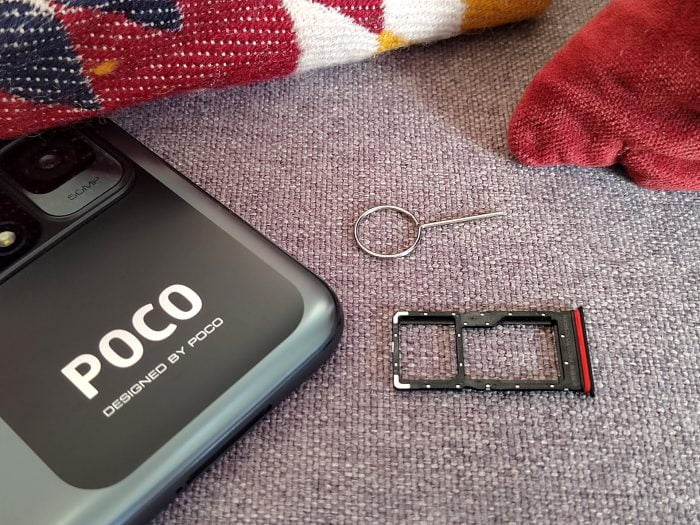
Wi-Fi and Bluetooth
The POCO M4 Pro is fast on the move in WiFi (Dual-AC) and impresses with its high data throughput and stable range. Bluetooth is available in version 5.1.
GPS and sensors
Navigating is also not a hurdle for the POCO M4 Pro. The GPS module quickly finds enough satellites to determine the position with an accuracy of a few meters. The signal is kept constant in the car. In addition to GPS, the satellite navigation systems Galileo, GLONASS and Compass (Beidou) are supported.
The other sensors include an ambient light sensor, an e-compass, a gyroscope, an acceleration sensor and an IR blaster. If you have misplaced the remote control of the television, you can control the television with the help of the IR blaster or infrared transmitter. All you need is an app (e.g. I Remote Controller), which can be downloaded free of charge from the Google PlayStore.
Fingerprint scanner and NFC
The fingerprint scanner is located on the side of the power button. The smartphone can be unlocked quickly with this. The recognition rate is good. NFC is also on board. Payment service providers such as Google Pay are supported.
Audio
The stereo speaker does a good job. The sound is balanced above and below and reaches a high volume. In any case, the stereo loudspeaker of the POCO M4 Pro does not sound like a tin can. Lows come into their own to some extent and the highs are also well covered. What is a bit blurred are the mids, which is particularly evident in vocals, which sometimes sound washed out.

Even though many users have now switched to wireless headphones, the 3.5 mm jack connector is fortunately still available.
Battery
The 5000 mAh battery of the POCO M4 Pro will get you through the day safely. Even more than 2 days of running time are realistic, provided you are one of the frugal users who mainly use the smartphone for phone calls, WhatsApp and web browsing. The consumption in standby or overnight is extremely low at just a few percentage points.
Of course, we also checked the 33 watt quick charge function in the test. Completely discharged, the battery was fully charged to 63 percent after exactly 100 minutes. That's very close to the 59 minutes that POCO is promoting. If you plug the smartphone into the power supply for just 30 minutes, the percentage display jumps to 55 percent.
Wireless charging is not supported. Although mentioned almost nowhere, the POCO M4 Pro supports so-called “reverse charging”. This makes the smartphone behave like a power bank and charges the battery of other devices in the opposite direction.

LITTLE M4 Pro 5G
Attractive design and good workmanship
Good performance in everyday life
Fast microSD slot
Main and front camera in good lighting conditions
NFC for mobile payment
Stereo speakers and jack connection
5G cellular
Outstanding battery life
Not a really outstanding highlight
No frills camera (4K etc.)
In the price range under 200 euros, the POCO M4 Pro is one of the few smartphones that can offer fast 5G cellular communications. The 90 Hz display is of good quality and its presentation is convincing. The performance of the Dimensity 810 chip is completely sufficient for everyday tasks. In demanding mobile games, however, the chip quickly reaches its limits. The camera has little to offer in terms of functionality, but the 50MP main camera takes decent photos and videos in good lighting conditions.
NFC for mobile payment and the large 5000 mAh battery with quick charge function round off the overall positive impression. However, you will look in vain for a prominent highlight. But that doesn't matter, because in its price range the POCO M4 Pro is still a well-equipped smartphone, for which we can make a recommendation without hesitation.

